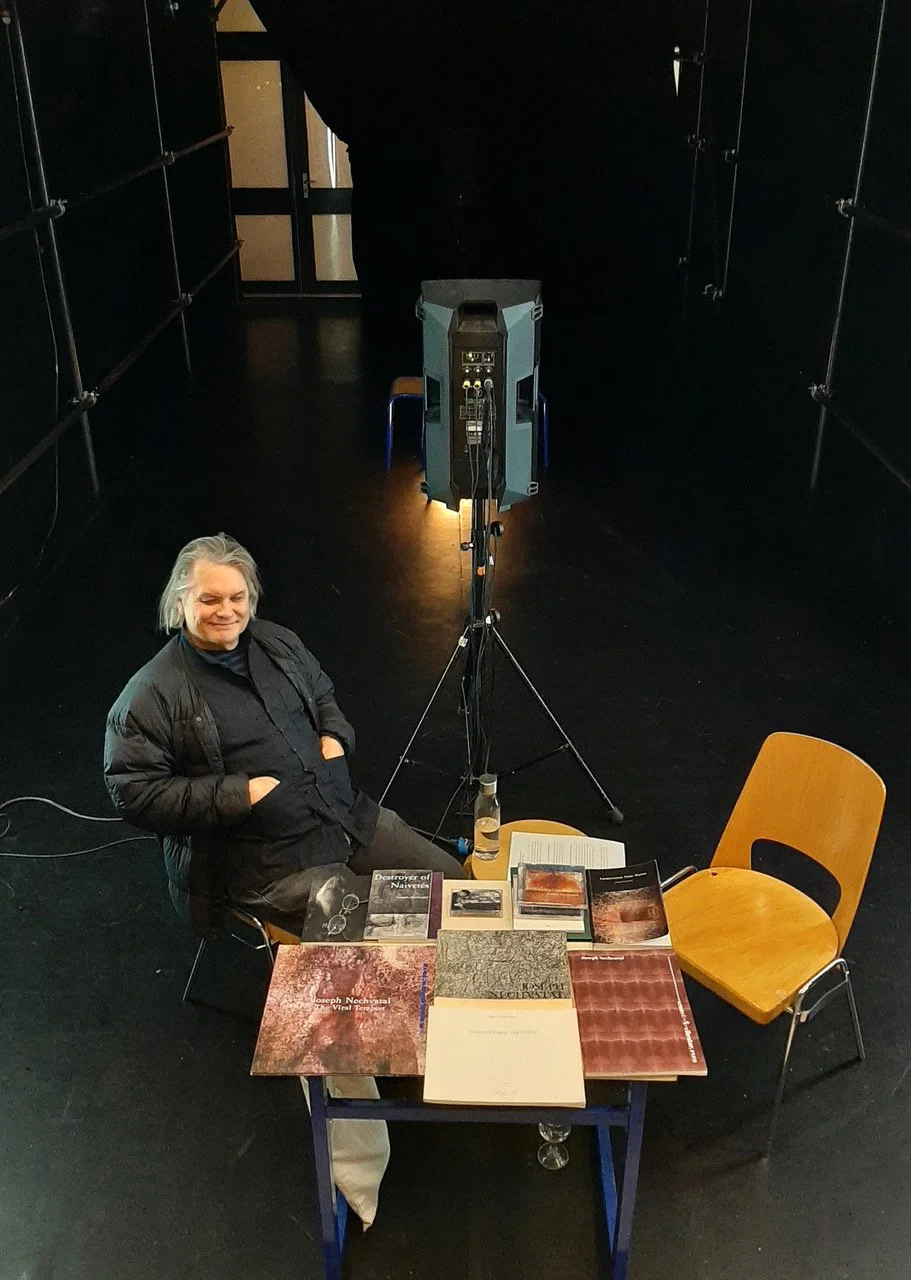The Marriage of Orlando and Artaud, even (translated from the French: Le Mariage d’Orlando et Artaud, même) derives from an audio installation of incisive minimalism and subtle rigor by post-conceptual artist and theoretician Joseph Nechvatal. As at the installation that premiered at La Générale Nord-Est in Paris in 2024, human couples take turns sitting back-to-back in the middle of a dark sound gallery, as if in a nuptial ceremony. Disembodied voices and strange sounds start drifting in from a second, virtual couple as if to seduce and harangue the actual couple. One stereo channel plays from one side of the room an endless loop of Nechvatal’s sound art composition OrlandO et la tempête viral symphOny redux suite, which draws from Virginia Woolf’s novella Orlando, a literary classic in gender-swapping.
From the other side of the room plays an endless loop on another channel, a second composition that blends noise music and cut-ups from Antonin Artaud’s 1947 radio play, Pour en finir avec le jugement de dieu. Sitting back-to-back, the listeners hear as if from opposite sides of a mirror. While one’s left ear is attuned to the sounds of the virtual-viral Orlando, their partner’s right ear is attuned to Orlando. Conversely, if one’s right ear is engaged with the virtual-viral Artaud, it will be the other’s left ear doing so, thus fostering a shared yet distinct auditory cross-engagement for both people.
This doubly stereophonic assault is a beguiling juxtaposition and an arch commentary on the perils of subjectivity, the intricate art of listening, the rewards of skillfully practiced patience, and the occasional guilty pleasure of diplomatic excess. Complex in theory but simple in execution, The Marriage of Orlando and Artaud, even can be handily recreated in the home environment so that any loving couple can experience it for themselves.
•••••
“When Joseph Nechvatal picked up Antonin Artaud’s Theater and the Plague (1933) in 2021, he was surely looking for tools to understand the social implications of the current plague, COVID-19 and its variant, alongside the many different plagues of his lifetime, whether HIV/AIDS, or the rising tide of computer viruses. All of these are connected by many things (global travel, human/animal land competition, and resource competition), but share a particular interest the structure of mutation. In viral mutations, traces of the original contagion persist even as variants wipe out the beneficial structures of resistance, whether they be antibodies, anti-viral medication, or various forms of avoiding social contact. The structure of this accelerated process of transformation is audible within individual works on this cassette. How to Kill (1986) audibly represents its source and its viral adaptation of fragmented cuts (Janet Jackson’s Nasty). Psychedelic Hermeneutic (1988) translates seventeen seconds of feedback from its source (Jimi Hendrix’s Are You Experienced?) into a minute-and-a-half exploration of feedback. The repetitions and feedings-back performing a near perfect analogue for viral reproduction as well as the bodies’ developing resistance through anti-bodies.
By 2006, the viral had jumped from recorded sound to a-life synthesis in viral symphony, whose visual analogue, Computer Virus Project II was developed with Stephane Sikora as a C++ a-life program. Without reducing any of these to the direct translation model of data sonification, this cassette perfectly frames the issue of contagion and variation as sonic perceptions. Nechvatal’s lifetime of work in data manipulation, data corruption, and multi-formatted AI/automata model for the past, present and future of viruses. We live now in an era where ‘going viral’ is desirable as a term of widespread cultural imprinting. But usually ‘going viral’ means the thing is unchanged as it spreads. This view separates contagion from transformation, which is at the center of Nechvatal’s practice. If you want to hear what’s gained in the translation, try listening to the source material (Jackson & Hendrix) and Nechvatal’s transformation of it. Or, find the imagery of Computer Virus Project II and listen to its musical counterpart.”
—Hannah Higgins
Joseph Nechvatal
The Marriage of Orlando and Artaud, even
2025
Table of the Elements
[Oxygen] 8
EOE-008
Perfect-bound book, 2x compact disc
“Joseph Nechvatal’s contemporary art practice engages in the fragile wedding of image production and image resistance. Through his version of an art-of-noise, he brings a subversive reading to the human body through computational viruses, articulating concerns regarding safety, identity and objectivity. Since 1986, Nechvatal has worked with ubiquitous electronic visual information, computers and computer-robotics. His computer-robotic assisted paintings and computer software animations are shown regularly in galleries and museums throughout the world.”
— Art Review World




